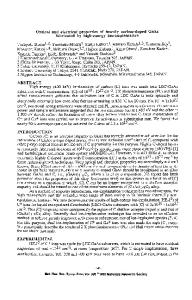Study of electrical and optical properties of ion-implanted polymers in relation to carbon structure
- PDF / 168,122 Bytes
- 5 Pages / 612 x 792 pts (letter) Page_size
- 84 Downloads / 280 Views
MATERIALS RESEARCH
Welcome
Comments
Help
Study of electrical and optical properties of ion-implanted polymers in relation to carbon structure Kazuo Sakamoto,a) Masaya Iwaki, and Katsuo Takahashi Riken (The Institute of Physical and Chemical Research), Hirosawa 2-1, Wako-shi, Saitama, 351-01, Japan (Received 6 September 1995; accepted 20 April 1996)
The relationship among electrical conductivity, optical properties, and carbon structure of ion-implanted polymers has been studied by optical transmission and Raman spectroscopy. The electrical conductivity, which depends not only on the ion dose but also on the dose rate in a complicated manner, was found to have a simple relation to the optical absorbance. By Raman spectroscopic analyses, the difference in the electrical conductivity was explained in terms of the difference in carbon structure.
I. INTRODUCTION
Organic polymers are subjected to change in composition and in chemical structure through interaction between implants and polymer parent atoms by ion implantation. Most of the polymers turn electrically conductive and optically dark in color by ion implantation which, being most remarkable changes in the material properties, is principally explained by carbonization of polymers through decomposition of chemical bonds and the growth of carbon-carbon conjugated chemical bonds,1–3 because carbon materials except diamond are black in color and electrically conductive. Electrical conductivity of ion-implanted polymers in general increases with an increase in ion dose under the conditions of same ion species and same implant energy,4,5 but there are some indications that the electrical conductivity also depends on the dose rate during implantation.1,6 Discussing the electrical conductivity of ion-implanted polymers, therefore, it seems necessary to take into account not only the ion dose but also the dose rate. However, until now very little information on this point of view has been available. In this paper, we have studied the dependence of electrical conductivity and optical properties on ion doses and dose rates, and investigated the relationship between electrical and optical properties.
was performed at does from 1 3 1015 ionsycm2 to 2 3 1017 ionsycm2 at an energy of 150 keV. The four edges of the substrate film were held on a target holder made of aluminum by a stainless steel sheet. In the case of ion implantation to PI films that have better heat durability, the dose rate could be chosen in the range from 0.5 mAycm2 to 5.0 mAycm2. For this reason, most of the experiments were carried out on the PI films On the other hand, in the case of ion implantation to PET and PPS films, the dose rate during ion implantation was kept lower than 1.0 mAycm2 in order to avoid breaking or distortion of the films caused by ion-beam heating. Sheet resistivity measurements were carried out in dry nitrogen atmosphere at room temperature by the two-electrode method, using silver conductive paste as the electrodes. Current voltage characteristics indicated ordinary ohmic r
Data Loading...









